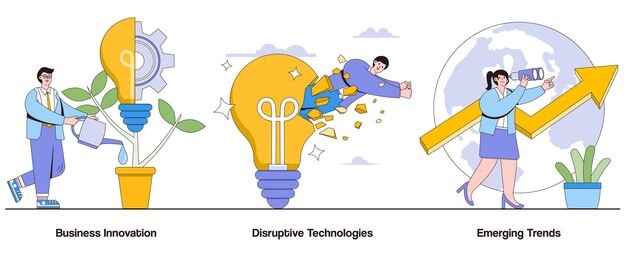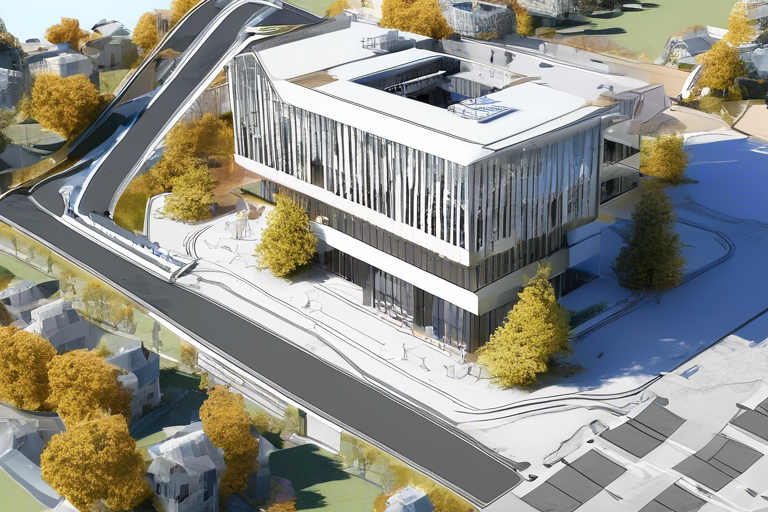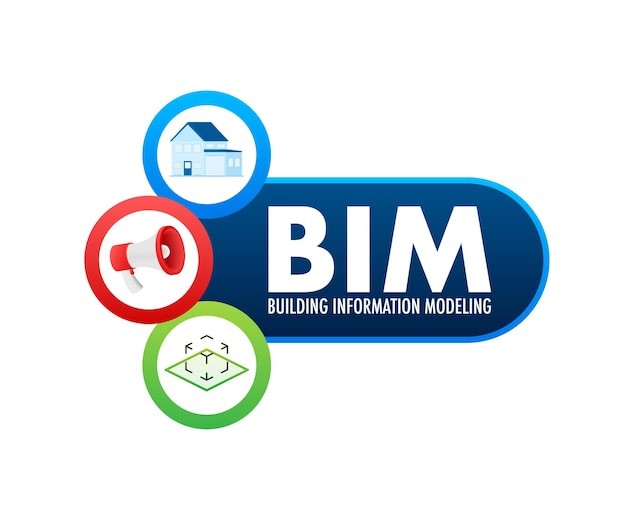
Building Information Modeling Software Market: Top BIM Software Companies, Latest Trends and Strategies 2024

Introduction to Building Information Modeling (BIM) software market.
Building Information Modeling (BIM) software has revolutionized the construction industry by providing architects, engineers, and contractors with a powerful tool to design, visualize, and simulate building projects. The BIM software market has witnessed tremendous growth in recent years, driven by the increasing adoption of digital technologies in the construction industry. In this article, we will explore the evolution of the BIM software market, the latest trends shaping the industry, key players in the market, and strategies to stay ahead in this evolving landscape.
Evolution of the BIM software market

The BIM software market has come a long way since its inception. Initially, BIM software was primarily used for 3D modeling and clash detection. However, with advancements in technology, BIM software has evolved to become a comprehensive platform that integrates various aspects of the construction process. Today, BIM software allows for collaboration among different stakeholders, enables the creation of detailed virtual models, facilitates project scheduling and cost estimation, and even supports facility management post-construction.
Latest trends in the BIM software market
The global building information modeling market size was valued at USD 7.9 billion in 2023 and is projected to reach USD 15.0 billion by 2028; it is expected to register a CAGR of 13.7% during the forecast period.
The BIM software market is constantly evolving, driven by technological advancements and changing industry needs. One of the key trends in the BIM software market is the move towards cloud-based solutions. Cloud-based BIM software offers several advantages, including easy access to project data from anywhere, real-time collaboration among team members, and automatic software updates. Another trend in the market is the integration of artificial intelligence (AI) and machine learning (ML) capabilities into BIM software. AI and ML can analyze vast amounts of data to identify patterns, optimize designs, and improve project outcomes.
This robust growth can be attributed to several factors. Foremost among them is the growing use of BIM due to its contribution to sustainable development. The rapid rise in urbanization globally, the wide-ranging benefits of BIM realized by the AEC industry, and the increasing government initiatives promoting the adoption of BIM also contribute to the escalated demand for BIM solutions.
Top Building Information Modeling Software Companies in 2024

Building Information Modeling (BIM) has become an essential tool in the Architectural Engineering and Construction (AEC) industry, revolutionizing the way buildings are designed, constructed, and managed. As the demand for BIM solutions continues to grow, several key players have emerged as leaders in the market. In this article, we will explore the top BIM software companies that are driving innovation and shaping the future of the industry.
1. Autodesk Inc.
Autodesk Inc., based in the United States, is a prominent player in 3D design, engineering, and entertainment software and services. The company offers a wide range of business solutions using the latest technologies. Their product offerings cater to architects, engineers, designers, manufacturers, media and entertainment professionals, as well as students and educators.
Autodesk Inc. has five product segments: Architecture, Engineering and Construction, Manufacturing, and Media and Entertainment. Their products can be broadly classified into AutoCAD, AutoCAD 3D, AutoCAD LT, BIM 360, CAM Solutions, and Fusion 360. The Architecture, Engineering, and Construction (AEC) segment includes AutoCAD, AutoCAD Civil3D, and Revit, which are widely used by industry experts for designing, engineering, and constructing buildings and civil infrastructure projects.
2. Nemetschek Group
Nemetschek Group, headquartered in Germany, is a leading software developer for the AEC and media & entertainment industries. The company operates in four reportable segments: Design, Build, Manage, and Media & Entertainment. Through their Design and Build segments, they offer BIM solutions to the AEC industry.
Nemetschek Group has a total of 13 brands, which are divided into four business segments: Design, Build, Media, and Manage. Their BIM software follows the open standard (Open BIM), allowing seamless communication between different software platforms. This interoperability enables the transfer of data, information, and digital models throughout the building's design, construction, and management phases. Their brands offer a broad portfolio of graphical, analytical, and commercial solutions, making them a key player in the BIM market.
3. Bentley Systems
Bentley Systems, headquartered in the United States, is a global software company that provides infrastructure design, construction, and operations solutions. They offer BIM software and solutions to architects, engineers, constructors, geospatial professionals, and owner-operators for designing, building, and operating various infrastructure assets.
Bentley Systems' BIM software and solutions include MicroStation, which is used for engineering and BIM applications, as well as digital twin-based Cloud services, ProjectWise for project delivery, and AssetWise for asset performance. Their software solutions cater to a wide range of industries, including railways, roadways, power plants, and industrial plants. They also provide BIM solutions for civil, structural, architectural, mechanical, electrical, and plumbing (MEP) disciplines.
4. Trimble Inc.
Trimble Inc., based in the United States, specializes in providing advanced positioning solutions, intelligent software, and hardware for industries such as construction, agriculture, transportation, and more. They offer a comprehensive suite of BIM software and solutions that enable collaboration and streamline workflows throughout the construction process.
Trimble's BIM software includes products like SketchUp, Tekla Structures, and Trimble Connect. These solutions help architects, engineers, contractors, and owners to visualize, design, and construct complex structures efficiently. Their software integrates data from various sources, enabling real-time collaboration and coordination among project stakeholders.
5. Dassault Systèmes
Dassault Systèmes, headquartered in France, specializes in 3D design, simulation, and product lifecycle management (PLM) solutions. Their software portfolio caters to various industries, including aerospace and defense, automotive, construction, consumer goods, energy, life sciences, and high tech.
Dassault Systèmes' BIM software and solutions are designed to optimize processes and efficiency in the construction industry. They offer products based on 3D, digital mock-up (DMU), project lifecycle management (PLM), and 3DEXPERIENCE platforms. These solutions enable all stakeholders to access necessary information and collaborate effectively throughout the project lifecycle.
6. Schneider Electric
Schneider Electric, headquartered in France, is a global leader in industrial engineering equipment, automation systems, and power distribution systems. They also provide hardware, software, and services related to energy management and automation systems. Schneider Electric offers BIM solutions under their Energy Management business segment.
Their Energy Management segment provides a range of products, solutions, and services for the energy sector, including power distribution, building automation, renewable energy, and industrial automation. Schneider Electric's products and services help businesses and individuals manage energy more efficiently, automate industrial processes, and improve the safety and sustainability of their operations.
These are just a few of the top BIM software companies that are driving innovation and shaping the future of the construction industry. With their advanced software solutions, they are enabling architects, engineers, contractors, and owners to design, construct, and manage buildings more efficiently and effectively. As the demand for BIM solutions continues to grow, these companies are expected to play a crucial role in transforming the way buildings are designed and built in the years to come.
"The future of the AEC industry lies in the hands of these top BIM software companies, who are revolutionizing the way buildings are designed, constructed, and managed."
The BIM Market by Deployment Type
The BIM market can also be categorized based on the deployment type, which includes On-Premise and Cloud deployment. While On-Premise deployment provides better control over data security and privacy, Cloud deployment offers high scalability, cost-effectiveness, and accessibility.
BIM and Project Lifecycle
BIM plays a crucial role in various stages of a project lifecycle. These stages include Pre-Construction, Construction, and Operation. BIM usage during the pre-construction phase aids in visualization, cost planning, and architectural designing, while its application during construction helps complete projects efficiently at lower costs. Lastly, BIM deployment during the operation phase improves building quality and efficiency.
BIM Application Areas
BIM finds its application in several areas, including Buildings, Industrial, Civil Infrastructure, Oil & Gas, Utilities, and others. The increasing number of construction projects worldwide has driven the use of BIM in buildings, while the growing use of BIM in public projects is driving the market in India.
BIM End Users
The end-users of BIM are primarily AEC professionals and Consultants & Facility managers. AEC professionals significantly contribute to BIM market growth, while consultants and facility managers use BIM to avoid or reduce cost overruns and delays.
BIM Market by Region
The BIM market is geographically distributed across North America, Europe, Asia Pacific, and the Rest of the World. North America holds the largest market share, followed by Europe and the Asia Pacific. The large-scale adoption of BIM in the construction industry of the US is driving the market in North America. In contrast, the adoption of BIM triggered by pilot projects is boosting the market in Germany.
Strategies to stay ahead in the evolving BIM software market
To stay ahead in the evolving BIM software market, it is essential to keep up with the latest trends and adopt innovative strategies. One strategy is to invest in research and development to develop new features and functionalities that address the emerging needs of the construction industry. This could include integrating emerging technologies like virtual reality (VR) and augmented reality (AR) into BIM software to enhance visualization and improve project communication. Additionally, fostering strong partnerships and collaborations with industry stakeholders can help in gaining insights into market needs and co-creating solutions that address specific pain points.
Another strategy is to prioritize customer satisfaction by providing excellent support and training services. Construction professionals often face challenges while adopting BIM software, and providing comprehensive training and support can help them overcome these challenges and maximize the value of the software. Additionally, actively seeking feedback from customers and incorporating their suggestions into software updates can enhance user experience and build customer loyalty.
Importance of BIM software in the construction industry
BIM software plays a crucial role in the construction industry, offering numerous benefits to architects, engineers, contractors, and other stakeholders. One of the key benefits of using BIM software is improved collaboration and communication among different teams and disciplines. BIM software allows for the seamless sharing of information, enabling all stakeholders to work together more efficiently and effectively. This leads to fewer errors, reduced rework, and improved project outcomes.
Furthermore, BIM software enables better project visualization and simulation. With BIM software, stakeholders can create detailed virtual models of buildings, allowing them to visualize the project before construction begins. This helps in identifying design flaws, optimizing space utilization, and improving overall project planning. BIM software also facilitates better project scheduling and cost estimation, helping in the efficient allocation of resources and timely completion of projects.
80% of the Forbes Global 2000 B2B companies rely on MarketsandMarkets to identify growth opportunities in emerging technologies and use cases that will have a positive revenue impact.
- Food Packaging Market Size Set for Strong Growth Through 2030 Amid Rising Demand for Convenience Foods
- Fertilizers Industry Set to Grow at 4.1% CAGR Through 2030
- Leading Automated Guided Vehicle Companies 2024: An In-depth Analysis
- CHARGED UP: SHIFT TO E-MOBILITY AND THE EVOLUTION OF TRANSPORTATION
- Global Automotive Market: Predictions For 2024
Benefits of using BIM software in construction projects
Using BIM software in construction projects offers a wide range of benefits. One of the key benefits is improved project efficiency. BIM software allows for better coordination among different teams, reducing clashes and conflicts during construction. This leads to faster project completion and cost savings. BIM software also enables better resource management by providing real-time data on material quantities, helping in accurate procurement and minimizing wastage.
Another benefit of using BIM software is enhanced project communication. BIM software allows stakeholders to visualize the project in 3D, making it easier to convey design intent and identify potential issues. This improves collaboration among different stakeholders, including architects, engineers, and contractors, leading to better decision-making and improved project outcomes. Additionally, BIM software facilitates better facility management post-construction by providing a digital record of the building's components, enabling efficient maintenance and repairs.

Factors to consider when choosing BIM software
When choosing BIM software, there are several factors to consider to ensure the best fit for your organization. One important factor is the software's compatibility with other tools and software used in your organization. Seamless integration with existing systems can streamline workflows and enhance productivity. It is also essential to consider the scalability of the software, as your organization's needs may change over time. Look for software that can accommodate future growth and can handle larger and more complex projects.
Another factor to consider is the level of support and training provided by the software vendor. A comprehensive training program and responsive customer support can greatly facilitate the adoption and effective use of BIM software. Additionally, consider the software's user interface and ease of use. Intuitive and user-friendly software can minimize the learning curve and increase user adoption.
Future outlook for the BIM software market
The future of the BIM software market looks promising, with continued growth and innovation on the horizon. As the construction industry embraces digital transformation, the demand for BIM software is expected to increase. The market is likely to witness further integration of emerging technologies like VR, AR, and AI into BIM software, enabling more advanced visualization, analysis, and optimization capabilities. The industry will also see increased emphasis on sustainability and energy efficiency, with BIM software playing a critical role in enabling sustainable design and construction practices.
Furthermore, the market is expected to witness increased adoption of cloud-based BIM solutions, allowing for better collaboration and data accessibility. The use of mobile devices and tablets for on-site BIM access is also expected to grow, enabling real-time project monitoring and communication. Overall, the future of the BIM software market is bright, with continuous innovation and advancements transforming the construction industry.
Conclusion
The BIM software market is rapidly evolving, driven by technological advancements and changing industry needs. To stay ahead in this dynamic landscape, it is crucial to keep up with the latest trends, invest in research and development, prioritize customer satisfaction, and foster strong collaborations. BIM software offers numerous benefits to the construction industry, including improved collaboration, better project visualization, and enhanced project efficiency. When choosing BIM software, consider factors such as compatibility, scalability, support, and user-friendliness. The future of the BIM software market looks promising, with continued growth and innovation on the horizon. Embracing BIM software is essential for organizations seeking to thrive in the ever-evolving construction industry.
****************
If you're looking to stay ahead in the evolving BIM software market and want to explore innovative solutions, get in touch with us today. Our team of experts can help you harness the power of BIM software and drive success in your construction projects. Contact us now to learn more.
Authored by Farhan Hussain, Co-Authored by Kevin Kelly, Co-author Shweta Surender, MarketsandMarkets


